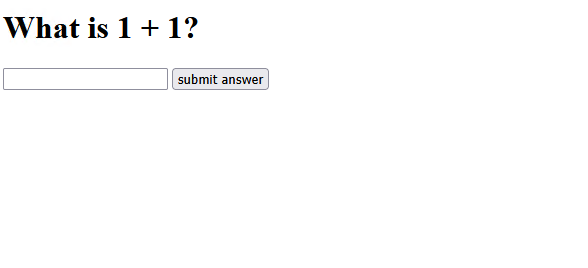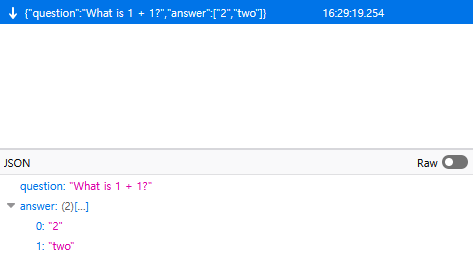welcome to my quiz! it is 4 questions and very hard. if you solve everything ill give u a cool flag!!!
One more year, one more season of LexMACS's very own LIT CTF event. Being the team's web main, I managed to solve 6 out of 9 challenges, and I'm doing some writeups for the ones I find interesting!
Our placement wasn't as high as last year, as local autist beerpsi was absolutely demolished by his finals, and it's mainly me doing solves. But, nonetheless, we had fun solving the challenges! Anyways, that's enough yapping, time for the actual challenge itself!
The challenge
We're given a simple website with a quiz, like below.

Answering each question correctly would move us on to the next one, and by taking a peek at the included questions.json file, you could see that we needed to reach the 5th question - the last one, to see the flag:
[
{
"question": "What is 1 + 1?",
"answer": ["REDACTED", "REDACTED"]
},
{
"question": "What is the molecular geometry of methane?",
"answer": ["REDACTED", "REDACTED"]
},
{
"question": "Turbo the snail is in the top row of a grid with 2024 rows and 2023 columns and\nwants to get to the bottom row. However, there are 2022 hidden monsters, one in\nevery row except the first and last, with no two monsters in the same column.\nTurbo makes a series of attempts to go from the first row to the last row. On\neach attempt, he chooses to start on any cell in the first row, then repeatedly moves\nto an orthogonal neighbor. (He is allowed to return to a previously visited cell.) If\nTurbo reaches a cell with a monster, his attempt ends and he is transported back to\nthe first row to start a new attempt. The monsters do not move between attempts,\nand Turbo remembers whether or not each cell he has visited contains a monster. If\nhe reaches any cell in the last row, his attempt ends and Turbo wins.\nFind the smallest integer n such that Turbo has a strategy which guarantees being\nable to reach the bottom row in at most n attempts, regardless of how the monsters\nare placed.",
"answer": ["REDACTED", "REDACTED"]
},
{
"question": "What is the answer to this question?",
"answer": ["REDACTED"]
},
{
"question": "LITCTF{REDACTED}",
"answer": [""]
}
]Poking around
Below's the challenge's main.js, included as part of the challenge's source code.
const ws = new WebSocket('ws://' + location.host + '/ws')
const input = document.getElementById('submission')
ws.onmessage = (event) => {
let data = JSON.parse(event.data)
document.getElementById('question').innerHTML = data['question']
input.value = ''
}
function start() {
document.getElementById('pre').hidden = true
document.getElementById('main').hidden = false
submit('')
}
function submit() {
ws.send(input.value)
}This opens up a WebSocket connection to the /ws endpoint, as described in index.js below. As you hit the submit button on the form, it will send the value through the WebSocket as the message.
const express = require('express')
const app = express()
const expressWS = require('express-ws')(app)
const PORT = 8080
const questions = require('./questions.json')
app.ws('/ws', function (ws, req) {
let count = 0
ws.on('message', (msg) => {
if (count < 4 && questions[count]['answer'].includes(msg)) {
++count
ws.send(JSON.stringify(questions[count]))
} else {
count = 0
ws.send(JSON.stringify(questions[count]))
}
})
})
app.get('/', function (req, res) {
res.sendFile('index.html', { root: __dirname })
})
app.get('/main.js', function (req, res) {
res.sendFile('main.js', { root: __dirname })
})
app.listen(PORT, () => {
console.log(PORT)
})Meanwhile, index.js is an Express app, that both serves our webpage for the form, as well as the WebSocket endpoint itself. It loads the questions set from questions.json, and upon receiving a message, it will check whether or not the message's value matches the current question's answer(s). If it does, it will increment the question counter, else, you'll be sent back to the first question.
A simple oversight
Giving this a bit of scrutinizing, you could see the entire thing is revolving around serializing the entire question and answer object through the WebSocket!
Both index.js:
let data = JSON.parse(event.data)
document.getElementById('question').innerHTML = data['question']...and main.js:
ws.send(JSON.stringify(questions[count]))sends and expects an entire object! What this means is, we can easily open up our Network tab in our browser's DevTools and inspect the WebSocket connection...

Answering all the questions with any of its answers would give us the flag as the last question, LITCTF{why_d1d_i_m4ke_thls}!
